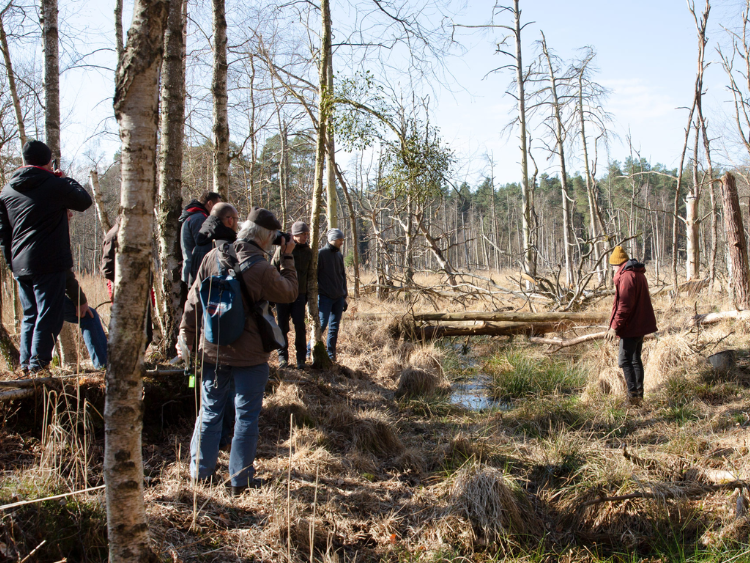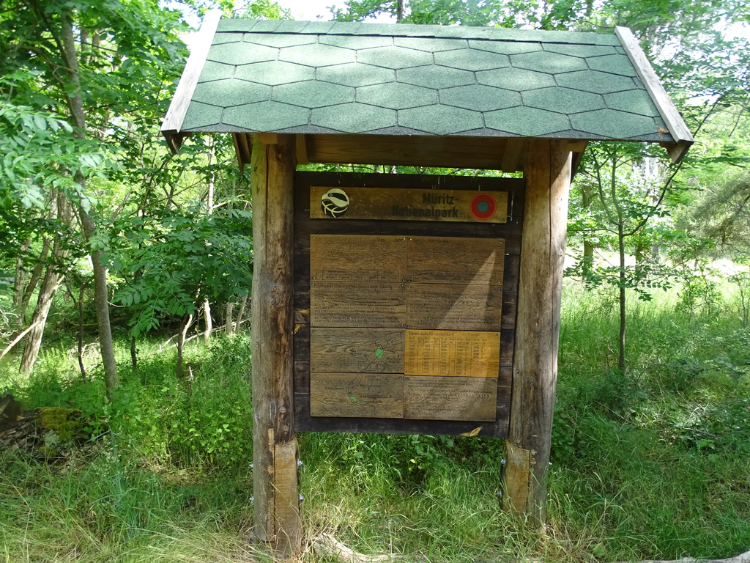
Müritz National Park is situated in the state of Mecklenburg-Vorpommern in northeastern Germany. The park encompasses the eastern shore of Lake Müritz, the largest lake entirely within Germany, and extends through the Müritz district.
Müritz National Park, located in the Mecklenburg Lake District, is one of Germany's largest national parks, covering approximately 322 square kilometers.
Here are some additional details about the park:
Location:
- **State**: Mecklenburg-Vorpommern
- **Nearby Towns**: The park is near the towns of Waren (Müritz), Neustrelitz, and Mirow.
- **Coordinates**: Approximately 53°20'N latitude and 12°45'E longitude.
Features:
- **Lakes and Wetlands**: The park features over 100 lakes, including Lake Müritz, the second largest lake in Germany, and other smaller lakes such as Specker See and Woterfitzsee.
- **Forests**: Dense beech and pine forests cover significant portions of the park, providing habitat for numerous species.
- **Flora and Fauna**: Müritz National Park is home to a variety of plant species and wildlife. It is particularly noted for its birdlife, including cranes, white-tailed eagles, and ospreys. The park also supports populations of red deer, otters, and numerous amphibians and insects.
- **Landscape**: The landscape is characterized by glacially formed hills, extensive moorlands, and pristine bodies of water.
Activities:
- **Hiking and Biking**: The park offers a network of well-marked trails for hiking and cycling, allowing visitors to explore its diverse ecosystems.
- **Boating and Canoeing**: Many of the park's lakes and waterways are accessible for boating and canoeing, providing a unique perspective on the park's natural beauty.
- **Wildlife Watching**: The park is an excellent destination for birdwatching and observing other wildlife in their natural habitats.
- **Visitor Centers**: Several visitor centers provide information about the park's natural and cultural history, as well as guidance for exploring the area.
Conservation:
- **Protected Area**: Müritz National Park is a protected area aimed at preserving its unique ecosystems and biodiversity. Efforts are made to maintain the natural environment and promote sustainable tourism.
- **Research**: The park is also a site for scientific research, focusing on ecology, conservation, and the impacts of climate change on natural habitats.
Accessibility:
- **Public Transport**: The park is accessible by train and bus from major cities like Berlin and Hamburg. Waren (Müritz) serves as a central hub for accessing the park.
- **Road Access**: It can be reached by car via the A19 and A20 motorways, with well-signposted routes leading to the park entrances.

Müritz National Park was officially established in 1990, following the reunification of Germany. It was created to protect the unique landscapes, biodiversity, and cultural heritage of the Mecklenburg Lake District region.
Here are some additional details about its creation and development:
Establishment:
- **Reunification Era**: The park was established shortly after the reunification of Germany in 1990. During this time, there was increased emphasis on environmental protection and the preservation of natural areas.
- **Former Military Area**: Parts of the land that now constitute the national park were previously used for military purposes, particularly by the East German army. After reunification, efforts were made to repurpose these areas for conservation and recreational purposes.
Development:
- **Expansion**: Since its establishment, Müritz National Park has undergone expansion and development. Additional land has been incorporated into the park, expanding its boundaries and protecting more natural habitats.
- **Infrastructure**: Infrastructure within the park, such as trails, visitor centers, and educational facilities, has been developed to accommodate visitors while minimizing environmental impact.
- **Research and Monitoring**: The park serves as a site for scientific research and monitoring, contributing to our understanding of ecological processes and biodiversity conservation.
Conservation Goals:
- **Biodiversity Conservation**: Müritz National Park aims to preserve the rich biodiversity of the Mecklenburg Lake District, including its forests, lakes, wetlands, and associated flora and fauna.
- **Habitat Protection**: Efforts are made to protect and restore natural habitats within the park, including forests, moorlands, and aquatic ecosystems.
- **Sustainable Tourism**: The park promotes sustainable tourism practices that allow visitors to enjoy its natural beauty while minimizing negative impacts on the environment.
Recognition:
- **UNESCO Biosphere Reserve**: Müritz National Park is part of the UNESCO-designated Mecklenburg Lake District Biosphere Reserve, which recognizes its importance for conservation and sustainable development.
- **European Diploma for Protected Areas**: The park has also received the European Diploma for Protected Areas, an international recognition of its efforts in nature conservation and management.
Public Engagement:
- **Education and Outreach**: The park engages with the public through educational programs, guided tours, and interpretation centers, raising awareness about the importance of conservation and environmental stewardship.
- **Recreational Opportunities**: Müritz National Park offers a range of recreational activities, such as hiking, boating, birdwatching, and wildlife observation, allowing visitors to connect with nature firsthand.
Müritz National Park stands as a testament to Germany's commitment to nature conservation and sustainable land management.

Müritz National Park was not "invented" by any individual; rather, it was established through a collaborative effort involving government agencies, conservation organizations, local communities, and other stakeholders. The park's creation was driven by the recognition of the ecological importance of the Mecklenburg Lake District and the need to protect its natural habitats and biodiversity. After the reunification of Germany in 1990, efforts were made to repurpose former military areas and promote conservation in the region, leading to the establishment of Müritz National Park and other protected areas in the area.


Müritz National Park is named after Lake Müritz, which is the largest lake located entirely within Germany and a prominent feature within the park. The name "Müritz" is derived from the Slavic word "mory" or "mori," meaning "sea" or "large body of water." Lake Müritz has historically been of great significance to the region, providing water resources, supporting local communities, and serving as a habitat for diverse flora and fauna.
The decision to name the national park after Lake Müritz reflects the importance of the lake within the park's ecosystem and its role as a focal point for conservation efforts in the Mecklenburg Lake District. Additionally, using the name "Müritz" helps to highlight the park's connection to the surrounding landscape and cultural heritage of the region.




Müritz National Park is an excellent destination for hiking lovers due to several reasons:
1. **Diverse Trails**: The park offers a variety of well-marked hiking trails that cater to different skill levels and preferences. Whether you're seeking a leisurely stroll through serene forests or a more challenging hike with panoramic views, Müritz National Park has options to suit your needs.
2. **Scenic Beauty**: Hikers in Müritz National Park are treated to stunning natural scenery, including lush forests, crystal-clear lakes, meandering rivers, and picturesque meadows. The park's diverse landscapes provide endless opportunities for exploration and discovery.
3. **Abundant Wildlife**: The park is home to a rich array of wildlife, including red deer, wild boar, otters, and a variety of bird species. Hiking through Müritz National Park offers the chance to observe these animals in their natural habitats, adding excitement and intrigue to your outdoor adventures.
4. **Peace and Solitude**: Müritz National Park encompasses vast expanses of unspoiled wilderness, making it an ideal destination for hikers seeking solitude and tranquility. Many of the park's trails lead through remote areas where you can immerse yourself in nature and escape the hustle and bustle of everyday life.
5. **Educational Opportunities**: Interpretive signs and visitor centers throughout the park provide valuable information about the area's ecology, history, and cultural significance. Hiking in Müritz National Park offers not only physical exercise but also opportunities for learning and appreciation of the natural world.
6. **Accessibility**: The park's hiking trails are easily accessible from nearby towns and villages, making it convenient for hikers to explore the area without extensive travel. Whether you're a seasoned trekker or a casual walker, Müritz National Park offers hiking opportunities for everyone to enjoy.
Müritz National Park's combination of diverse trails, scenic beauty, abundant wildlife, solitude, educational opportunities, and accessibility makes it a top destination for hiking enthusiasts looking to connect with nature and embark on memorable outdoor adventures.






Yes, Müritz National Park offers hiking opportunities year-round, each season providing its own unique experience:
1. **Spring**: Spring is a wonderful time to hike in Müritz National Park as the landscape comes alive with vibrant colors. The forests are filled with blooming flowers, the trees are budding, and migratory birds return to the area. Hiking during this time allows you to witness the rejuvenation of nature after the winter months.
2. **Summer**: Summer brings warm temperatures and longer daylight hours, making it an ideal time for longer hikes and exploration. The forests are lush and green, and the lakes are inviting for a refreshing swim after a hike. However, it's important to bring insect repellent during the summer months, as mosquitoes and other insects can be prevalent.
3. **Autumn**: Autumn in Müritz National Park is a spectacle of colors as the leaves on the trees change to vibrant shades of red, orange, and yellow. Hiking during this season offers stunning views of the foliage reflected in the park's lakes and rivers. It's also a great time for wildlife watching, as many animals prepare for winter by foraging for food.
4. **Winter**: Winter transforms Müritz National Park into a winter wonderland, with snow-covered landscapes and frozen lakes. While hiking during this time may require additional preparation and suitable clothing, it offers a unique and peaceful experience. Snowshoeing and cross-country skiing are popular winter activities in the park, allowing visitors to explore the snowy trails and enjoy the tranquility of the winter landscape.
Regardless of the season, Müritz National Park offers hiking opportunities for all preferences and fitness levels. However, it's important to check weather conditions and trail accessibility before embarking on a hike, especially during the winter months when certain trails may be closed or require additional equipment.